p.1071
p.1075
p.1079
p.1083
p.1087
p.1091
p.1095
p.1099
p.1103
Conductive Sol-Gel Hybrid Materials for Novel Cofactor Regeneration in Biocatalysis
Abstract:
The electrochemical recycling of cofactors during enzymatic biocatalysis has long been acknowledged as a potentially powerful technology in fine chemical synthesis. Major obstacle for this approach is that cofactors only in the immediate vicinity of the electrode surface are productive. This problem further causes high overpotential at electrode surfaces leading to undesired side reactions producing enzymatically-inactive dimer and isomer of cofactor. So far, several attempts had been made to address these problems by focusing on surface modifications, which explored to retain the enzyme and/or cofactor close to the working electrode including electrode deposition and membranes surrounding the electrode. In this work, we demonstrate a new concept of cofactor regeneration by using ‘electronically-conductive’ sol-gel hybrid materials. When conductive hybrid gels were added to the reaction medium, we found that cofactor could be efficiently recycled throughout the whole reactor system leading to high yield of product, which was unattainable with conventional technologies.
Info:
Periodical:
Pages:
1087-1090
Citation:
Online since:
June 2007
Authors:
Price:
Сopyright:
© 2007 Trans Tech Publications Ltd. All Rights Reserved
Share:
Citation:


